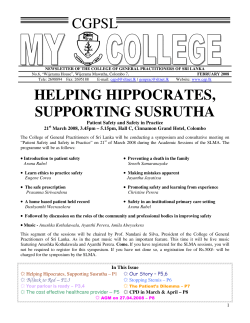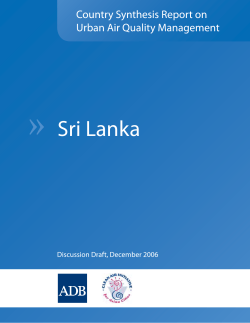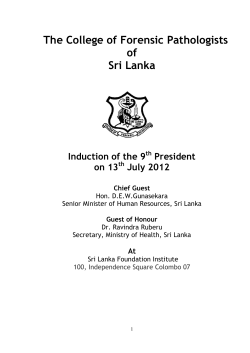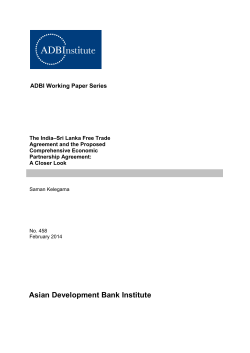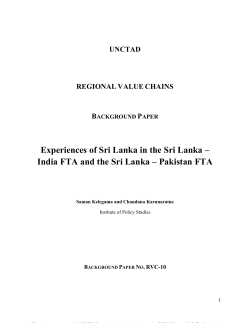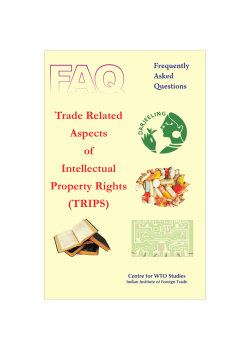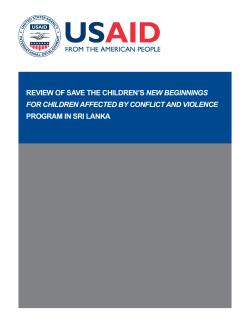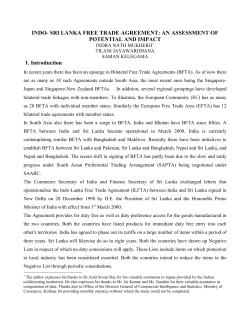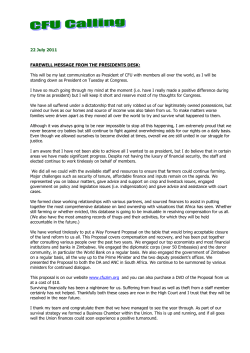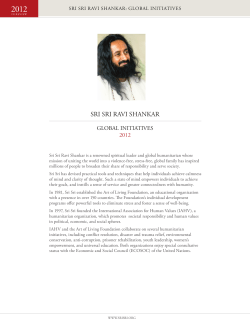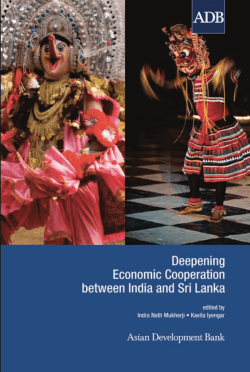
T r a d
Asia-Pacific Research and Training Network on Trade Working Paper Series, No. 92, January 2011 Trade Related Intellectual Property Rights (TRIPS) Agreement and the Agriculture Sector in Sri Lanka by Dilani Hirimuthugodage* * Research Assistant, Institute of Policy Studies (IPS), Colombo, Sri Lanka. The author wishes to thank Dr. Parakrama Samaratunga and Mr. Manoj Tibbotuwawa at the Institute of Policy Studies for their valuable inputs and comments on the paper. The author is grateful to Prof. Sirimal Abeyratne at the University of Colombo for supervising the work on the thesis. This work was carried out as part of the authors Masters Thesis at the University of Colombo. The technical support of the United Nations Economic and Social Commission for Asia and the Pacific (UN ESCAP) is gratefully acknowledged. The opinion figures and estimates are the responsibility of the author and should not be considered as reflecting the views or carrying the approval of the United Nations, ARTNeT and the IPS. Any errors are the responsibility of the author, who can be contacted at dilani@ips.lk The Asia-Pacific Research and Training Network on Trade (ARTNeT) is aimed at building regional trade policy and facilitation research capacity in developing countries. The ARTNeT Working Paper Series disseminates the findings of work in progress to encourage the exchange of ideas about trade issues. An objective of the series is to get the findings out quickly, even if the presentations are less than fully polished. ARTNeT working papers are available online at www.artnetontrade.org. All material in the working papers may be freely quoted or reprinted, but acknowledgment is requested, together with a copy of the publication containing the quotation or reprint. The use of the working papers for any commercial purpose, including resale, is prohibited. 1 Table of Contents Executive Summary ........................................................................................................................ 4 1. Introduction ............................................................................................................................. 6 2. Intellectual property rights and economics ............................................................................. 8 3. An in-depth view of the TRIPS agreement ............................................................................. 9 3.1 Evolution ......................................................................................................................... 9 3.2 Structure ........................................................................................................................... 9 4. TRIPS and agriculture........................................................................................................... 10 5. TRIPS agreement from a Sri Lankan perspective................................................................. 13 5.1 Laws and policies relating to plant varieties and farmers’ traditional knowledge in Sri Lanka................................................................................................. 15 5.2 Application of the TRIPS agreement in Sri Lanka ........................................................ 16 5.3 Sri Lankan experiences .................................................................................................. 17 5.4 Analysis of the Sri Lankan status quo............................................................................ 18 6 Conclusions and recommendations....................................................................................... 27 References ..................................................................................................................................... 30 Appendix 1: Perception survey questionnaire............................................................................... 32 Appendix 2: Semi-structured questionnaire for in-depth interviews ........................................... 36 2 List of Figures Figure 1: Perception survey response rate..................................................................................... 18 Figure 2: Different issues faced by Sri Lanka in protecting plant varieties and farmers .............. 19 Figure 3: The importance of IPR in agriculture ............................................................................ 20 Figure 4: Sri Lanka without IPR rules .......................................................................................... 21 Figure 5: Importance of an IPR system for Sri Lanka .................................................................. 21 Figure 6: Institutions responsible for preparing IPR rules ............................................................ 22 Figure 7: Intellectual Property Rights Act No: 36 ........................................................................ 22 Figure 8: Proposed bill on Protection of New Plant Varieties (Breeder’s Rights) bill 2001 ........ 23 Figure 9: Factors for development of the agricultural sector ........................................................ 24 Figure 10: Main stakeholders in improving plant varieties........................................................... 25 Figure 11: Methods of protecting plant varieties and farmers’ rights........................................... 25 Figure 12: Methods for protecting plant varieties and farmers’ rights ......................................... 26 Figure 13: Flow chart on recommendations.................................................................................. 29 List of Boxes Box 1: Article 27 of the TRIPS agreement ................................................................................... 11 Box 2: Recent example for bio-piracy in Sri Lanka...................................................................... 17 3 Executive Summary One of the main objectives of the World Trade Organization (WTO) is to facilitate the world’s trade and production. It enforces legally binding multilateral agreements on trade in goods, services, and trade-related aspects of intellectual property rights to manage global trade efficiently. At the end of the Uruguay Round of the General Agreement on Tariffs and Trade (GATT) in 1994, the Trade Related Intellectual Property Rights (TRIPS) agreement was implemented to regulate standards of Intellectual Property (IP) regulations in WTO member countries. Being a member of the WTO and a signatory to the TRIPS agreement, it is compulsory for Sri Lanka to formulate its IP regulations to comply with the TRIPS agreement by the year 2006. There are seven types of intellectual properties which are protected by the TRIPS agreement and it establishes minimum universal standards concerning copyrights and related rights, trademarks, geographical indicators, industrial designs, patents, layout designs of integrated circuits and undisclosed information. Section 5, Article 27 is the most important provision involving the agricultural sector. According to the agreement Sri Lanka had to provide legal protection to plant varieties and farmers traditional knowledge via patents or by an effective sui generis system or by both, by the said year 2006. However, the agreement provides for each country to determine and adopt a suitable procedure to implement the provisions of the agreement within its legal system and practices. Sri Lanka passed its Intellectual Property Rights Act No.36 to comply with the TRIPS agreement in the year 2003. However, this Act does not directly provide protection for plant varieties and farmers’ traditional knowledge as it does not allow patenting of plants. Prior to the IPRs Act in 2003, Sri Lanka drafted a protection of new plant varieties (Breeders rights) Bill in 2001; which is still at the initial bill stage. Due to several reasons such as; lack of demand from civil society, poor legal system, lack of properly established institutional system, etc., Sri Lanka was unable to build an effective intellectual property rights regime complying with the agreement, especially for the agricultural sector. Further, due to delay in establishing relevant rules and regulations to comply with the agreement, the Sri Lankan agricultural sector has to face several difficulties especially in international trade and also it has lost a number of opportunities to use its own plant varieties for the benefit of future generation due to loss of patentability in plant varieties and farmers traditional knowledge. The TRIPS agreement has given flexibility to all countries in selecting the protection methods and techniques for plant varieties and farmers traditional knowledge. Thus, most of the developed countries have adopted well-built intellectual property regimes using strong patent systems and plant breeder’s rights. The main reason for developed countries to choose patents for protection is due to their technological capabilities and the immense financial benefits that a patent system is expected to generate. Whereas, developing countries have weak regimes due to lack of financial and technical support. 4 The perception survey and face to face interviews amongst key stakeholders attempted to identify the best possible method for Sri Lanka to adopt in order to protect plant varieties and farmers traditional knowledge. Simultaneously, it suggested several techniques and methods that could be followed in implementing intellectual property right rules in agriculture in order to promote investments and accelerate trade internationally. 5 1. Introduction Approximately 33 percent of the labour force in Sri Lanka is engaged in agriculture which constitutes 12 percent of the Gross Domestic Product. (Central Bank, 2009). Although, the importance of the agricultural sector is gradually declining, it continues to play a dominant role in the economy where approximately, 75 percent of the population still falls into the rural category, most of whom are engaged in agricultural activities. Sri Lanka is rich with a repository of natural resources; in fact it has been recognized as one of the best places in the world for wild and agro biodiversity, with Sri Lanka holding more than 50 percent of the flowering plant families recorded in the world. The country is rich in biological diversity including its agricultural biodiversity, and is identified as one of the 24 biodiversity hotspots in the world (Nanayakkara, 2007). Sri Lankan agro biodiversity has plant varieties with special traits which suits different uses and different agro climatic conditions. Farming practices and the continuous selection of plant varieties by Sri Lankan farmers over centuries have made a wide range of cultivated plants. Those involved in farming and cultivation specialize their knowledge in several areas, especially knowledge of science in soil, rotation and mixing of crops, methods of sowing, watering and reaping, saving seeds for future use etc. Hence, their knowledge of science in farming is also recognized as an important element in agriculture as is labour. This knowledge individually is the intellectual property of the farmer, which gradually become the property of a country as a common property. 1 In any country, agricultural development is primarily based on different crop varieties grown by farmers which results in high productivity. Traditional knowledge of plant genetic resources is under threat (Trade Insight, 2007). In the recent past, the demand for private ownership on plant varieties increased rapidly due to the global push for privatization of biodiversity. Many developed countries, and the large businesses increasingly want to control these resources and the knowledge associated with farmers for commercial purposes. Issues concerning plant genetic resources in Sri Lanka are multifaceted (Weerasinghe, 2004). This comprises all endangered flora, agricultural resources such as vegetables, fruits and grains, horticulture and medicinal plant resources. The exploitation and over exploitation of plants genetic resources takes place mainly in the form of bio-theft and bio-piracy (Gunasekera, 2007). As far as Sri Lankan legislation is concerned, it is evident that Sri Lanka does not have the necessary rules and regulations to halt bio-theft and bio-piracy (Gunesekera, 2007). Due to the lack of a strong legal and institutional system, Sri Lanka had to face many cases of bio–piracy and loss of patents based on indigenous knowledge. The case of Kothalahibutu (Salacia Reticulate) clearly highlights the exploitation of wild varieties and the production of drugs based on traditional knowledge to which patent rights have been granted to Japan. The patent granted to the Japanese company prevents future generations of Sri Lankans from using 1 Protecting farmers’ rights in the global IPR regime, available at; www.farmersrights.org/resources/global_articles_16.html).accessed on 25/03/2009 6 and producing similar drugs. It was identified that by the year 1985, twelve plants from Sri Lanka were patented in Japan 2 (Gunesekera, 2007). However, Sri Lanka has certain rules and regulations to protect plant and animal varieties. Most of these Acts and Ordinances 3 provide physical protection for natural resources and there are no specific laws relating to plant genetic resources and farmers traditional knowledge. Most of these laws were passed many decades ago. More recently, Sri Lanka has ratified international conventions 4 regarding plant varieties and farmer’s rights. Most of the developing countries have faced several difficulties in protecting their plant varieties and farmers’ traditional knowledge from the developed world which mainly attributes to lack of strong rules and regulations. Biological resources and farmers’ traditional knowledge and skills have not been registered or documented in most developing countries and with the globalization process, bio-diversity and the traditional knowledge, skills and technologies possessed by local farmers in developing these varieties are at stake. Global Multi-National Companies (MNCs) have engaged in bio-piracy of vital genetic resources and associated traditional knowledge found in developing countries to get patent rights for their own countries. In this process, the developing countries are continuously denied the benefits which legitimately belong to them. 5 Hence, the need for universally accepted rules and regulations to protect plant varieties and farmers rights has strongly been felt. One of the main highlights of the Uruguay Round negotiations which concluded in 1994, was the establishment of the World Trade Organization (WTO). It was the first ever comprehensive international organization which provided necessary recognition to Intellectual Property Rights (IPRs). The agreement on Trade Related Aspects of Intellectual Property Rights (TRIPS) is the most comprehensive international instrument ever negotiated on intellectual property rights. It establishes minimum universal standards concerning patents, copyrights, trademarks, industrial designs, geographical indications, integrated circuits and undisclosed information (trade secrets). It further supplements by providing additional 2 Patent licenses have also been obtained for Snake Gourd (Trichosanthis Krilowii), Bitter Gourd (Momodica Chatantia),Kekatiya (Aponnogeton Crispus) etc. 3 For an example; Fauna and Flora Protection Ordinance, Forest Ordinance as amended in 1995, Plant Protection Act No: 35 of 1999 etc. 4 UN Convention on Biological Diversity (CBD) etc. 5 E.g. The patenting of Indian basmati rice variety by the Rice Tech company, USA, granting patent of an Indian traditional wheat variety by the European Patent Office to Monsanto over NapHal, patenting the entire gene sequences of rice by the Swiss M.N.C Syngenta, and patenting medicinal properties of turmeric, neem, jamoon, bitter gourd and such other Indian varieties and the associated knowledge, by the USA and the European M.N.Cs are only a few well known cases of bio piracy of Indian biological diversity and traditional knowledge. The Pakistan basmati rice patent was owned by the USA, Philippines Soil microbes was patented in the USA, Philippines Banaba (Lagerstroemia sp) was patented by Japan, Thailand Jasmine Rice was patented in the United States of America etc. (GRAIN and Kalpavriksh, 2002). These can be identified as some of the famous bio-piracy cases recorded in Asia – Pacific regions. 7 obligations to the previously established Paris, Berne, Rome and Washington conventions 6 in their respective fields (The TRIPS agreement a guide to South). The most relevant section in the TRIPS agreement with regard to agriculture is section 5, Article 27, which is titled “Patentable Subject Matter”. This article states: “Patent shall be available for any invention, whether product or process in all fields of technology, provided that they are new, involves an inventive step and are capable of industrial application”. Being a member of the WTO, the Sri Lankan intellectual property rights regime has to be in conformity with the TRIPS agreement. It allows member countries to grant patent protection to microorganism and non biological and microbiological process and to provide protection for plant varieties, either by patent or an effective sui generis system or a combination thereof (Article 27, TRIPS agreement). Sri Lanka passed its Intellectual Property Act No.36 in 2003 to comply with TRIPS. However this law does not have direct bearing on biodiversity and farmers’ rights as it does not allow patenting of plants. However, previously Sri Lanka has drafted a protection of new plant varieties (Breeders rights) Bill in 2001. IPRs have being well formulated and well applied more in developed countries than in developing countries. It is said that TRIPS has resulted in gross injustice to the South Asian countries, particularly to its farming and indigenous communities.7 However, Sri Lanka is lagging far behind the other countries in formulating and implementing property rights pertaining to the agricultural sector, especially on plant varieties and farmer’s traditional knowledge. Therefore, the agricultural sector in Sri Lanka is vulnerable to outside exploitation because of its inability to provide necessary protection for plant varieties and farmers’ traditional knowledge. Hence, having sufficient rules and regulations to protect plant varieties and farmers traditional knowledge is a strongly felt need at present. 2. Intellectual property rights and economics Economic theory suggests that intellectual property rights could either enhance or limit economic growth. However, evidence is emerging that stronger and more certain IPRs could increase economic growth and foster beneficial technical change, thereby improving development prospects (Maskus, 2000). Nevertheless, the significance of these growth effects would be dependent on the circumstances in each country. However, with the appropriate complementary policies and transparent regulation, IPRs could play an important and positive role in promoting economic growth. There are two central economic objectives of intellectual property protection. Firstly; to promote investments in knowledge creation and business innovation by establishing exclusive rights to use and sell newly developed technologies, goods, and services. Secondly; to promote widespread dissemination of new knowledge by encouraging (or requiring) rights holders to place 8 Prior to TRIPS, the Paris Convention for the protection of industrial property and the Berne Convention for the protection of literary and artistic work set down the initial foundations for a multilateral framework of an international intellectual property rights regime. 7 http://www.sawtee.org/pdf/IPRs%20in%20Agriculture_FR%20Nepal2008.pdf), accessed on 25/3/2010 8 their inventions and ideas on the market (Fink and Maskus, 2005).When there is a lack of intellectual property protection or weak intellectual property rights, firms are not willing to incur costs in research and commercialization activities. In economic terms, weak IPRs create a negative dynamic externality (Fink and Maskus, 2005), and fail to overcome the problems of uncertainty in R&D and risks in competitive appropriation that are inherent in private markets for information. In an economic context, it is socially efficient to provide wide access to new technologies and products, when they are developed at marginal production costs. IPR rules are important in-terms of encouraging creativity and innovation; to transfer technology on commercial terms to business enterprises in developing countries; to protect consumers by controlling the trade of counterfeit goods; and to improve international trade activities (WIPO, 2009). By strengthening IPR regimes, either unilaterally or through adherence to TRIPS agreement, developing countries attempt to attract greater inflow of technology. There are three interdependent channels through which technology is transferred across borders. These channels are international trade in goods, foreign direct investment (FDI) within multinational enterprises, and contractual licensing of technologies and trademarks to unaffiliated firms, subsidiaries, and joint ventures. Economic theory observes that technology transfers through each channel partly depend on local protection of IPRs, albeit in complex and subtle ways (WIPO, 2009). Furthermore, countries with weak IPRs could be isolated from modern technologies and would be forced to develop technological knowledge from their own resources. 3. 3.1 An in-depth view of the TRIPS agreement Evolution Due to tremendous growth in technological innovations in industrialized countries and significant increase in world trade, the establishment of an institute to address the issues of intellectual property rights became necessary. The first effort was made by the USA to initiate an Anti-Counterfeiting Code made during the General Agreement on Tariffs and Trade (GATT) in the Tokyo Round (Stewart, 1999). As a result of the Uruguay Round, a GATT working group on TRIPS was established. 3.2 Structure TRIPS is an international agreement which sets minimum standards for many forms of IP regulation. TRIPS constituted Annexure 1C of the Marrakesh Agreement, 8 which established the WTO. TRIPS is intended to maximize the contribution of intellectual property systems to economic growth through accelerating trade and investment. The agreement covers five broad issues: 8 The Marrakesh Agreement was the final act of the Uruguay Round of GATT negotiations which was concluded in Marrakesh, Morocco and was effective since 1st January 1995. 9 How basic principles of the trading system and other international intellectual property agreements should be applied to improve trade? How to give adequate protection to intellectual property rights? How countries should enforce those rights adequately in their own territories? How to settle disputes on intellectual property between members of the WTO? Special transitional arrangements during the period when the new system is being introduced. The main objective of the agreement is explained in Article 7. “The objective is to provide protection and enforcement of intellectual property rights which should contribute to the promotion of technological innovation and to the transfer and dissemination of technology to the mutual advantage of producers and users of technological knowledge and in a manner conducive to social and economic welfare and a balance of rights and obligations”. According to Article 65, WTO members must ensure their laws meet the minimum standards laid down in the TRIPS agreement. Countries according to their development progress have different time periods for implementation, which are as follows; Developed countries had to implement TRIPS within one year of the agreement commencing into effect on 1st January 1995 Developing countries had a grace period of four years, i.e., by 1st January 2000 Economies in transition (from centrally – planned to market economies) also had an extra four years, i.e., to 1st January 2000 Least developed countries have a 10 year transition period which could be extended for a further period. Countries that are members of TRIPS are required to legislate or to promulgate IPR laws, rules and regulations for the implementation of the minimum requirements of TRIPS in their respective jurisdictions, including the enforcement of IPRs through civil and administrative procedures and remedies. 4. TRIPS and agriculture The TRIPS agreement represents the existing global state of IPR standards and legally binds all its member countries. It is the only agreement amongst several multilateral agreements under WTO which have significant impacts on global trade (Maskus, 2000). TRIPS has a direct impact on agricultural trade and development, particularly agricultural biotechnology (WIPO, 2009), and its impact on agricultural trade is comparatively more important for developing countries as agriculture is still a significant stakeholder in many of these countries’ GDP, especially in Asian countries. In addition, many of the poor in Asia depend on agriculture for their livelihood. The key element of the TRIPS agreement for the agricultural sector is the requirement for WTO members to make patents available for any inventions in the sector. The most important article in the agreement when considering the agricultural sector is Article 27, which reads as follows: 10 Box 1: Article 27 of the TRIPS agreement SECTION 5 Article 27: Patentable Subject Matter Patents shall be available for any inventions, whether products or processes, in all fields of 1. technology, provided that they are new, involve an inventive step and are capable of industrial application. Patents shall be available and patent rights enjoyable without discrimination as to the place of invention, the field of technology and whether products are imported or locally produced. 2. Members may exclude from patentability inventions, the prevention within their territory of the commercial exploitation of which is necessary to protect ordre public or morality, including to protect human, animal or plant life or health or to avoid serious prejudice to the environment, provided that such exclusion is not made merely because the exploitation is prohibited by their law. 3. Members may also exclude from patentability: (a) diagnostic, therapeutic and surgical methods for the treatment of humans or animals; (b) plants and animals other than micro-organisms, and essentially biological processes for the production of plants or animals other than non-biological and microbiological processes. However, Members shall provide for the protection of plant varieties either by patents or by an effective sui generis system or by any combination thereof. The provisions of this subparagraph shall be reviewed four years after the date of entry into force of the WTO Agreement. Article 27.2 indicates that interventions may be excluded from patentability in member’s territory only if it is necessary to prevent the exploitation of the intervention in order to protect public order and morality. Article 27.3 states the items excluded from patentability. Table 1 explains the three types of protection under the TRIPS agreement for plant varieties. Member countries have the freedom to select one of the options mentioned in the table below. Table 1: Options for the protection of plant varieties in TRIPS Option 1 Option 2 Option 3 WTO members can choose to protect plant varieties through patents WTO members can develop an effective sui generis system to protect plant varieties. This means they should bring an effective national law that grants IPR over new plant varieties through plant breeders’ right certificates. WTO members can develop a system that gives patents as well as plant breeders’ “rights certificates” to protect plant varieties. Source: Farmers’ Rights, 2007 11 A sui generis (of its own) system of protection is a special system adapted to a particular subject matter, as opposed to protection provided by one of the main systems of intellectual property protection, e.g., the patent or copy rights system (Sahai, 2000). Further, it is a mild or a diluted form of a patent and it provides a framework of plant breeder’s rights through which protection is accorded to the breeders, researchers, and farmers with regard to use and exchange of seeds and plant genetic materials (Maskus, 2000). According to the TRIPS agreement, there is an imperative requirement on the part of the person applying for a patent protection to disclose the invention in such a manner that would enable a person skilled in the art to make and use the invention in the future. The application of IPRs in agriculture, as allowed under TRIPS, has long been debated, mainly due to its provisions under Article 27. Article 27.3 (b) indicates that the governments can exclude certain kinds of inventions from patenting, i.e., plants, animals and biological processes. The Article however states that it is mandatory for WTO members to provide patent protection to micro-organisms and non-biological and micro –biological processes on the basis of three patent eligibility criteria (patent, sui-generis or by both) 9 . Hence, this is a rather confusing statement which does not provide a precise or an exact method for member countries to follow. Given the significant contribution of agriculture in Asian economies, and its rich biodiversity, the impact of this provision on Asian agriculture is very significant. Furthermore, the rapid developments in biotechnology, and its tremendous application to agriculture in Asia may justify the inclusion of IPRs in agricultural trade (Beronio, and Payumo, 2002). It is said that IPRs are formulated and applied well in developed countries rather than developing countries (Sahai, 2000). A number of developing and least developed countries believe that the TRIPS agreement has created a route for the inventors to obtain “excessively broad patents” in a manner that perpetuates and legitimizes bio-piracy and threatens the rights of local, indigenous and farming communities over their biological resources and associated technological knowledge (GRAIN and Kalpavriksh). Even though most of the developing countries are rich with these genetic resources, they lack technological and financial resources to fully exploit these resources. The Asia-Pacific region has a rich diversity of plants which have been used by people for many generations. The majority of people in the Asia-Pacific region still rely directly on this diversity of plants, or plant genetic resources, for food and medicine. In developing countries, patents for micro-organism and plant variety protection are the most important areas in agriculture (Sahai, 2000) as most of their livelihoods depend on the subsistence agricultural system. In agriculture, traditional knowledge held by a farmer is important in the development and adaptation of plants and crops to different ecological conditions (soils, rainfall, temperature, altitude etc). Traditional knowledge is people’s awareness and understanding of the system and other information, which is passed on from one generation to the next, usually by word of mouth 9 www.wto.org , accessed on 10/06/2010 12 or within a specified group of people. Indigenous knowledge is often used interchangeably with traditional knowledge. Most of the debate about traditional knowledge at the international level is taking place in the context of IPR. It is through IPR, and particularly patents, that control and ownership over traditional knowledge is being usurped by commercial interests. The IPR system is now being proposed as a system to protect traditional knowledge. Due to the lack of a clear and sufficient IPR regime, there are a number of bio-piracy cases recorded in South Asia. Bio-piracy 10 , or the stealing of genetic material and knowledge from communities in the gene-rich developing countries, is an exploding issue in Asia. Industrialised countries want exploitation and ownership rights over the biodiversity of developing countries. The term can also be used to suggest a breach of a contractual agreement on the access and use of traditional knowledge to the detriment of the provider and bio-prospecting without the consent of the local communities (GRAIN and Kalpavriksh). There are several bio- piracy cases recorded in South Asia. 11 In 1985, twelve medicinal plants of Sri Lanka were patented in Japan (J.P.NO: 60054312 of 28/03/1985) for the extracts used in toothpaste, gargles, ointments or chewing gum, manufactured by Nissan, Tsurui and Yakuhin. This is the first ever known bio piracy incident in Sri Lanka. (Gunesekera, 2007). It has being identified that one of the key factors for the development process of a country is promotion and investment in indigenous, innovative and inventive activities. One way of achieving this target is to provide a legal framework for intellectual properties. Therefore, it is important for a country to have clearly defined IPR rules and regulations on its plant varieties and traditional knowledge. 5. TRIPS agreement from a Sri Lankan perspective The agricultural sector of Sri Lanka is dualistic in nature. The two sectors are; export oriented plantation sector and food crop production sector. The export oriented plantation sector produces tea, rubber and coconut whereas the other sector produces paddy, subsidiary food crops, vegetables and fruits. Agriculture is the most important sector of the Sri Lankan economy. Even though its contribution to the gross domestic product declined substantially during the past 3 decades (from 10 Bio-piracy can be defined as the stealing of knowledge from traditional and indigenous communities or individuals. 11 Indian neem (Azadirachta Indica) is another example. Several companies have obtained the patent for Neem. The US multinational company W.R.Grace’s EPO has obtained the following licenses: US Patents including No.s 5420318, 5391779 and 5371254; Kothalahimbutu (Salacia reticulata) in Sri Lanka has been recognized abroad for its ability to control diabetes. In the year 1997 a Japanese company (Japan, US Takama System, Ltd. (Yamaguchi, JP)’s US Patent No. 6,376,682) was granted a patent for a medicine to control diabetes. This medicine is based on the traditional use of kothalahimbutu. At present Sri Lanka does not have the patent right for Kothalahimbutu whereas the Japanese company gains all the benefits by producing the drug. 13 30 percent in 1970 to 12 percent in 2009), it is an important source of employment for the majority of the Sri Lankan workforce, where approximately 38 percent of the total labour force was engaged in agriculture in the year 2009. The agricultural sector is sometimes referred to as the "subsistence agricultural sector", which is also provided with a fair degree of protection from imports. It is assisted with subsidized inputs, particularly fertilizer, seeds and planting material, and through other support measures, such as low interest credit, guaranteed marketing through parastatals and virtually free irrigation water. 12 When considering the farming system in Sri Lanka, low land paddy farming can be identified as the most widely practiced system. Chena cultivation is another form of farming system. This system consists of rain fed cultivation based on slashing and burning of forests, scrub or grasslands. Home gardens can also be identified as another farming system. There are several farming practices followed by the farmers of Sri Lanka. One such practice is mixed and multi-storied cropping, whereas another is crop rotation. Mulching is also a practice which uses crop residue or any other organic litter to cover the exposed soil between growing crop plants. The farming systems and practices reveal that agriculture in Sri Lanka still remains in the subsistence level, and uses traditional farming techniques. All the above mentioned methods are based on organic agriculture. Traditional farming in Sri Lanka mostly uses indigenous knowledge and traditional agricultural equipment and tools, while modern farming has adhered to certain standards or at least accepted norms in cultivation methods and practices. Seed production in Sri Lanka is an organized network. The National Seed Policy (NSP) 13 on the production, importation, certification and distribution of seed and planting material recommended increased private sector participation in seed production and distribution, and the enactment of a seed law to regulate the quality of seed (Perera, 2004). The following institutes can be identified as seed producing and marketing institutes under the guidance of the Department of Agriculture (DoA):- Seed Certification and Plant Protection Centre, Plant Genetic Resources Centre, Plant Protection Center, Seed and Planting Material Development Center, etc. Paddy seeds are entirely produced locally. In the year 2009, DOA produced 1691.8 Mt paddy seeds and the private sector provided 795.5 Mt. Both DOA and the private sector produced 19% of the total paddy seed requirement and the balance was self-produced by farmers. Vegetable seed production in Sri Lanka is very low. At present the import value of vegetable seeds remains at 3.5 Mn per year. Other Field Crops (OFC) are produced locally and 12 Agriculture, trade and food security issues and options in the WTO Negotiation, available at; www.fao.org/DOCREP/003/X4829E/X4829E00.HTM 13 NSP was declared in 1996. Prior to that monopoly power of production, supply and importation of seeds were under DOA. 14 are also imported. Planting material of tea, rubber, coconut, cocoa and coffee are produced locally. 5.1 Laws and policies relating to plant varieties and farmers’ traditional knowledge in Sri Lanka At present Sri Lanka has implemented very few rules and regulations with regard to protecting plant varieties and farmers traditional knowledge. Most of these Acts and Ordinances were passed many decades ago and deal with natural resources which collectively indicate a policy in favour of the physical protection of natural resources. However, there are no specific laws relating to plants genetic resources and farmers traditional knowledge. Fauna and Flora Protection Ordinance as amended by Fauna and Flora Protection (Amendment) Act NO: 49 of 1993 It provides protection for “National Reserves” which are sub-classified into various types that attracts different levels of protection. The most stringently protected area is the “Strict Natural Reserves” of which there are only three such reserves, namely Hakgala, Ritigal and Yala (part). Forest Ordinance as amended in 1995 This Ordinance deals with the protection of forests and regulations in respect to felling and transportation of timber. Under this Ordinance “forest” means all forest, waste, chena, uncultivated or unoccupied land at the disposal of the State. Rubber Control Act/ Tea Control Act These two Acts prohibits the exporting of the “seed, root, stump or bud” of any rubber or tea plant, without a permit from the Rubber or Tea Controller. Plant Protection Act No: 35 of 1999 The plant protective Act attempts to protect plant and plant products from contamination by pests outside, while not shutting the door to using selected pests’ beneficial potential for scientific purposes. It is of importance to farmers to the extent that it seeks to prevent contamination of local agricultural crops by invasive species not hitherto found in Sri Lanka. Seed Act No 22 of 2003 This is an Act to regulate the quality of seed and planting materials and to provide for matters connected therewith or incidental thereto. The national seed council was established under this Act. Similarly, Sri Lanka has ratified several international conventions to safe guard plant varieties and farmer’s rights. One such important convention is; UN Convention on Biological Diversity (CBD) which was adopted in 1992 and came into force in 1993. Sri Lanka ratified it in 1994. The objectives of this Act include: the conservation of biological diversity, sustainable use of genetic resources and the fair and equitable sharing of benefits from the use of genetic resources. 15 Proposed Bill on the Protection of New Plant Varieties (Plant Breeders’ Rights) in 2001 This was drafted in the year 2001; however, it still remains a bill, where several arguments were raised. For example; the proposed bill covers only the “new varieties”, which raises a question as to the position of traditional varieties, varieties bred by the DOA, varieties bred by other enterprises etc. However, it is observed that the proposed bill is identical to the UPOV 1991 Act, which Sri Lanka is not a signatory to. As explained before most of the crop seeds in Sri Lanka are imported. For example in the year 2009, Sri Lanka produced (DOA and the private sector) nearly 349,331 Kg of seeds and imported approximately 879,136 Kg. Except for rice, Sri Lanka mostly depends on imported seeds especially for vegetables and for other field crops. According to the interviews carried out it was noted that the higher percentage of seed imports discourage the government to implement new laws to protect new plant varieties. Simultaneously, the pressure from civil society to the government is also at a very minimal level. Furthermore, the priorities of the government in the past were for the most part focused on the civil war and not the agricultural sector. These factors can be identified as reasons for the government delaying the implementation of IPRs for new plant varieties by enacting the new draft bill. 5.2 Application of the TRIPS agreement in Sri Lanka Sri Lankan intellectual property law followed the British law on intellectual property until 1978. Since signing the TRIPS Agreement, the Government of Sri Lanka is obliged to introduce rules and regulations to protect plant varieties and breeders rights. Having such laws are necessary to attract new and advanced technologies and to provide incentives to plant breeders. Sri Lanka needs to improve its agricultural technologies to meet the increasing food needs of the growing population. Sri Lanka passed its Intellectual Property Act No.36 in 2003 to comply with the TRIPS agreement. However, this law does not have a direct bearing on biodiversity and farmers’ rights as it does not allow for the patenting of plants. It was stated that most farmers presently depend on the hybrid varieties of seeds for higher yields. Providing possibilities for new plant breeders by protecting their rights is a necessary step in achieving these developments. An effective and productive intellectual property system is considered as an important component for a nation’s advancement (Abeysekera, 1999). The issues relating to farmer’s rights and plant varieties in Sri Lanka arise basically due to three reasons. Lack of laws and policies or the deficiencies contained therein Improper enforcement Lack of awareness, knowledge, malpractices at grass root levels etc.(Gunesekera, 2007) Most of the developing countries lack the institutional, financial and human capacity to implement a strong IPR regime (Trade Insight, 2007). Therefore, they have to face many difficulties in international trade. Globally, few developed countries, such as the USA and Australia, with industrialized agriculture have opted to protect plant varieties not only by plant 16 breeder’s rights but also by patents due to their technological capabilities and the immense financial benefits that a patent system is expected to generate. When considering developing countries for an example; Thailand and India where subsistence agriculture is the norm the plant protection mechanism is as follows; Thailand Plant Variety Protection Act 1999 provides important provisions to breeders of new varieties, rights of farmers, protect plant genetic resources etc. In India the enactment of plant breeder’s rights was a direct outcome of India’s commitment under the TRIPS agreement. As the Indian Patent Act excludes patenting of living organisms, the other option under the TRIPS agreement to protect plant varieties by plant breeder’s rights was adopted by India. In 2002 the Indian parliament passed the Protection of Plant Varieties and Farmer’s Rights Act granting breeders and farmers in India the right to claim intellectual property protection over their varieties. 5.3 Sri Lankan experiences Several cases of bio-piracy have been recorded in Sri Lanka due to the inability to implement the necessary rules and regulations to safeguard plant varieties and farmers traditional knowledge. For example; the most popular case is known as Kothalahibutu (Salacia Reticulate), which clearly highlights the exploitation of wild varieties and the production of drugs based on Sri Lankan traditional knowledge to which patent rights have been granted to Japan and the USA. Furthermore, the patent granted to the Japanese company prevents future generations in Sri Lanka from using and producing similar drugs. In 1985, 12 medical plants from Sri Lanka were patented in Japan (J.P.No.60054312 of 28/3/85) for the extracts used in toothpaste, gargles, ointments or chewing gum, manufactured by Nissan, Tsurui and Yakuthin. Box 2: Recent example for bio-piracy in Sri Lanka The Case of Salacia reticulate (kothalahimbutu) Kothalahimbutu, is a sub species of Himbutu, a plant confined to some parts of India and Sri Lanka. Salacil Reticulata or Kothalahimbutu is quickly becoming popular as a means of diabetes control (Dissanayake and Haduneththi, 2006). Sri Lankan Ayurvedic exponents evolved a cottage industry of hand carved Kothalahimbutu mugs and jugs aimed at the domestic market. Ayurvedic medicine advises a person suffering from diabetes to drink water left overnight in a mug carved out of kothalahimbutu wood. Pharmaceutically advanced countries moved fast to take the patent rights for kothalahimbutu. Earlier, Japanese researchers managed to isolate Salacinol from this plant which is described as a potent glucose inhibitor and last year a Japanese company patented Salacinol through the American Chemical Society. Meanwhile, a Japanese company entitled Jintang has begun the manufacturing and world wide distribution of a diabetic arresting tablet using Salacinol. In a similar manner 25 other plant extracts have been patented abroad (Dissanayake and Haduneththi, 2006). The foreign companies which have taken patents for traditional medicinal extracts 17 indicate that, that plant cannot be patented in Sri Lanka again. The product made from that plant or the process of extraction can be only patented if it is a new invention. Every medicine that is produced using extracts from local plants are sold back to consumers at exorbitant prices, and if some day Sri Lanka decides to manufacture their own pharmaceuticals using plant extracts patented elsewhere, the right to do so is firmly restricted by the companies who gathered Sri Lankan ground produce for a few rupees. Hence, it is important to strengthen the existing legal system and take necessary steps to protect plant varieties and farmers rights with out any further delay. 5.4 Analysis of the Sri Lankan status quo Analysis of the Sri Lankan position was based on a perception survey which was conducted among 50 selected main stakeholders by using a questionnaire 14 in which 32 stakeholders responded. Face to face interviews were based on a semi structured questionnaire 15 where six main stakeholders in the field were interviewed. The perception survey response rate is 64 percent and Figure 1 provides a detailed overview of the respondents. It should be noted that the response rate of politicians is 0 percent. Even though they are one of the main stakeholders, it was not possible to get an appointment to meet them due to their busy schedules and election activities. Figure 1: Perception survey response rate The perception survey questionnaire covered significant aspects of the TRIPS agreement and the Sri Lankan agriculture sector. The main purpose of the questionnaire was to get stakeholders views on this issue and their suggestions. Respondents had to rank their views on 14 15 Perception survey questionnaire is attached in Appendix 1. Semi-structured questionnaire is attached in Appendix 2. 18 the question given on a scale from 1 to 5 (Likert Score System). They were asked to tick or highlight the numbers that best represent the strength of the rules and regulations (or the statement) available in Sri Lanka to protect plant varieties and farmers rights. The lowest number (0) represents the most ineffective, whereas the highest number (5) represents the most effective. If a respondent’s view on a questions asked is low he/she will mark it as 0, and if it is a favourable view or if he/she thinks that the said statement is highly effective he/she will mark it as 5. Similarly, if they have moderate views respondents will record a number between 1 and 5. Analysis is based on the average of all selected stakeholders and some selected questions were analysed according to their groups. Figure 2: Different issues faced by Sri Lanka in protecting plant varieties and farmers Figure 2 explains five types of issues faced in protecting plant varieties and farmers rights. According to respondents’ views, the main issue is lack of knowledge and awareness amongst the general public and thus, the selection of respondents (who have both agriculture and legal backgrounds) for the survey was a very difficult task. Not only the general public, but the main stakeholder group (farmers), are not aware of these issues due to lack of education and also due to communication barriers. Most of the farmers live in rural areas and they are basically not interested in these issues. Rural farmers also fall into the poverty category and they have other priorities. In this analysis civil society represents farmers and farmer associations. Awareness amongst the general public on this issue is vital because they are the group of people with a voice, who can influence the government and national regulations/laws. In comparison to Sri Lanka, India is much further ahead when it comes to general public awareness of this issue; in fact India got back the patents which were taken by a USA Company for Turmeric and Basmati. In this process civil societies played a major role. They are the category which can impress upon the government and also encourage it to take action against such companies. Hence, general public awareness on the need to protect indigenous plant varieties and farmers traditional knowledge is very important in preparing rules and regulations. Stakeholders’ views on issues involving the protection of plant varieties and farmers rights can be further ranked as follows; the second issue is lack of institutions to prepare and monitor intellectual property rights. Even though there are institutions to monitor the system they do not 19 operate effectively due to several reasons. One such reason is the influence of politics. Although there are a number of institutions working on this area, there is no effective link amongst them and each institute works separately. In face to face interviews this point was discussed at length and one interviewer who represented the policy maker category also highlighted this. “Lack of co-operation amongst responsible institutions and competent authorities in SL” -Policy makerThe third factor is the inadequacy of law enforcement. Even though there are laws relating to natural resources and plants, practical implementation of such rules are at a very low level. The hindrance of the implementation process is mainly due to the lack of strong and powerful institutions and a very low demand from civil society. Thus, the use of available laws and regulations are very limited. Stakeholders have ranked malpractices at grass root levels as the fourth factor. This factor is a common scenario in many segments of the economy and this delays the enforcement of available rules and regulations. Lack of available laws and regulations is ranked as the final issue. Although Sri Lanka has very few laws and regulations to address the problem of protecting plant varieties and farmers rights, the implementation process of it is at a minimum level. The survey has also proved that the issues mentioned above are inter-linked with each other, thus the solution for one issue will involuntarily help to address the other issue. Simultaneously, negative factors in one issue will directly and indirectly affect the other. Figure 3: The importance of IPR in agriculture The importance of IPR in agriculture is ranked under two titles. The respondents have marked acceleration in international trade with strong IPR at 58%, whereas the effect of IPR in stimulating investments is ranked as 42%. IPRs provide incentives to inventors to develop new 20 knowledge, new technology, etc., whereas with weak intellectual property rights institutions are not willing to incur costs in research and development activities. Hence, it is important to have a strong IPR system in order to develop the sector. When considering the agricultural sector, IPR in plant varieties is very important for the future development of the sector. Figure 4: Sri Lanka without IPR rules Figure 4 gives an overview as to whether Sri Lanka will be better-off without IPR rules and regulations with regard to the agricultural sector and also the country’s position if Sri Lanka did not implement laws with regard to the TRIPS agreement. In the answers provided by the stakeholders, they have indicated that it is important to have rules that comply with the TRIPS agreement. As stated above, the scores given for the two statements are below the average value (2.5). Both give a value of less than 2, which indicates the necessity of having rules and regulations to comply with the TRIPS agreement. Figure 5: Importance of an IPR system for Sri Lanka : Figure 5 describes the different views of the selected stakeholders regarding the importance of IPR for Sri Lanka. All five categories have ranked it above average. Policy makers who 21 represent the Directors of the Department of Agriculture, Intellectual Property Rights office, and policy makers from several Ministries have identified the importance of IPRs in the economic development of a country and they have provided an average of 4.6. Government officers who represent the Department of Commerce, Ministry of Fisheries and Aquatic Resources, Ministry of Agriculture and Agrarian Services, and the Central Bank have indicated the second highest value for the importance of the IPR. Civil societies which comprise farmer associations (farmers) have ranked it as 4. Lawyers who are involved in the field of IPR have also marked it as 4. The academia category which involves university lecturers and researchers indicated 3.45, which is ranked low compared to other group’s values. Although politicians are one of the main stakeholders to this survey they are not included due to difficulties in getting appointments to meet them. Figure 6: Institutions responsible for preparing IPR rules Institutions which are needed to make IPR rules can be identified as follows: Department of Agriculture, Intellectual Property Office, Ministry of Environment, Civil society and Ministry of Legal Affairs. Figure 7: Intellectual Property Rights Act No: 36 22 Even though Sri Lanka has passed the Intellectual Property Rights Act No:36 in 2003, it does not cover the IPR aspects in agriculture and also it doesn’t provide sufficient protection for plant varieties. Support given by this Act for research and development in the agricultural sector is very minimal. A new Act was drafted in the year 2001(not implemented yet) to comply with the TRIPS agreement. The new Act on Protection of New Plant Varieties (Breeder’s Rights) was particularly drafted to address these issues. Figure 8: Proposed bill on Protection of New Plant Varieties (Breeder’s Rights) bill 2001 This is still in the bill stage. In the survey, the stakeholders have identified the importance of having a plant breeders Act to protect farmers’ traditional knowledge and the importance of plant breeders’ rights in order to enhance the free exchange of genetic resources. The following statements are made by stakeholders during interviews and the survey: “We can develop new varieties if there is free exchange of genetic resources. However, the genetic resources of endemic species can also be exchanged. This process will be accelerated with the assistance of plant breeder’s rights” 23 -Agricultural Economist“We have to be well armed with regulations and legal aspects first; plant breeder’s rights should be given priority” -Policy maker- Department of Commerce “Lawfully recognized rights and effective methods of enforcement are a must for the development of the sector” -Lawyer“Some of the plant breeders could misuse the provisions available for their personal gains due to lack of proper and strong regulations” -Policymaker- Department of Agriculture “Free exchange of genetic resources has been the practice through MOU and CGPRT centres. However, limited opportunities have arisen for Sri Lankan breeders due to weak breeders rights” -Agricultural EconomistFigure 9: Factors for development of the agricultural sector Respondents have ranked four types of factors which facilitate the development of the agricultural sector in Sri Lanka. They have ranked farmers’ traditional knowledge as the first. In Sri Lanka, farming methods that have been practiced for thousands of years have led to today’s rich array of cultivation through changing the crop breeding practices and genetic make-up of plants. Continuous selection of these varieties by the Sri Lankan farmers over centuries and the availability of a wide range of agro-ecological conditions have led to the creation of a wealth of agro bio-diversity within the country. Secondly, the available plant varieties are also vital for the development of the sector. Sri Lanka is a country with a rich repository of natural resources including wild and agro biodiversity. Hence, it is important to get full use of the existing resources. Available technology is recorded as the third factor in the development processes. Improved technology helps to develop different types of new varieties which will increase the productivity of the sector. Finally, the exchange of genetic resources is ranked as a developmental factor. As mentioned 24 earlier, to get the maximum use of the germ plasm exchange there should be strong policies to regulate it. Figure 10 depicts the most important stakeholders in improving plant varieties. Stakeholders have ranked the Department of Agriculture as the main institution responsible for improving plant varieties, whereas the farmers who learn things by experimenting and introducing new types of varieties rank second. Figure 10: Main stakeholders in improving plant varieties Figure 11: Methods of protecting plant varieties and farmers’ rights This is one of the most important questions in the questionnaire. The TRIPS agreement suggests two options namely; the Patents or the Sui generis system to protect plant varieties and farmers rights for its members. Selected stakeholders have suggested the Sui generis system as 25 the most appropriate method for Sri Lanka; this system is ranked at 69 %. The TRIPS agreement provides flexibility in deciding what protection method to use by considering the country’s agricultural economy and future objectives. Hence, Sri Lanka has the freedom to select the most suitable method and techniques to protect its plant varieties and farmers rights. Patent protection is a strong method to use, however for a country like Sri Lanka it is very difficult to implement patents considering the immense financial cost and technology that is required to implement patents. Therefore, it was revealed that the sui-generis system would be the most appropriate method for plant variety protection in Sri Lanka. Figure 12: Methods for protecting plant varieties and farmers’ rights Figure 12 describes the different categories of stakeholder views on the selection methods. All five stakeholder groups have selected the sui generis system as the first priority. Policy makers and lawyers have selected it as the most effective method by marking it as 5. All five scores are above the average. Only the policy makers provided an above average figure for patents. Stakeholders’ suggestions to improve the protection for plant varieties and farmers traditional knowledge are as follows: “Create a special committee with key personal from the relevant authorities in this regard and create an action plan giving responsibilities amongst them.” -Policy maker- Department of Agriculture “As more countries participating in a legal system that addresses concerns specific to biological material, legislation will become more meaningful” -Government Officer in Agricultural field“Maintaining arboretums to protect plant varieties” -Agriculture Economist- 26 “Cooperation with countries (especially Asia and Africa) having homogenous features in PGR to create a common understanding (the countries that have the richest bio diversity should get together” -Policy maker- Department of Commerce “It is important to have a strong and well equipped IPR system to protect traditional plant varieties. Also there should be good institutional backing to implement these regulations. However, these laws and regulations should not be too restrictive which hinder the movement of R&T affecting technological advances” -Lawyer- 6. Conclusions and recommendations As a member of the WTO and as a signatory to the TRIPS agreement, Sri Lanka is required to implement a plant breeder rights system to protect plant varieties and farmers traditional knowledge. However, the TRIPS agreement did not impose any restrictions on selecting the protection method. The government has absolute authority to select the most suitable method for its economy and to its agricultural pattern. Therefore, the country has the opportunity to formulate their own system depending on their current situation and future priorities. Hence, Sri Lanka had the flexibility in deciding the most suitable method and implementing it prior to the year 2006. Sri Lanka implemented the Intellectual Property Act No: 36 in 2003 to comply with the TRIPS agreement. However, this act has excluded patent protection for animals and plants. According to Article 62 of the 2003 Act, plants, animals and other micro organism other than transgenic micro organism and essentially biological processes for the production of plants and animals other than non-biological and microbiological processes can not be patented. The intellectual property office in Sri Lanka has drafted a bill on the protection of plant varieties (breeder’s rights) in the year 2001. However, this is still at the bill stage due to several objections that came from experts in the field. Due to the delay in implementing laws to protect plant varieties and farmers traditional knowledge, Sri Lanka is facing various difficulties in international trading and also it is in a perilous position in loosing its plant varieties especially medicinal plants and farmers traditional knowledge. As discussed above, intellectual property protection promotes investments and international trade flows. Simultaneously, it plays a significant role in encouraging innovation, product development, and technical changes in the development process. It was recognized that there is a positive relationship between IPRs and the economic development of Sri Lanka. Economic development of the country with IPRs happens through two channels namely; higher investments and international trade. As a developing country Sri Lanka should take advantage of the arrangements provided by the TRIPS agreement and adopt a sui generis plant variety protection law that will support the development of the indigenous agriculture sector and subsistence farming communities. 27 The following recommendations are based on face to face interviews and the perception survey conducted amongst selected stakeholders. It is identified that there is an inter-link between issues that affect the implementation of rules and regulations to protect plant varieties and farmers traditional knowledge. It was revealed that the sui generis system would be the most appropriate method for Sri Lanka. Therefore, under the TRIPS agreement, Sri Lanka has the flexibility to decide the most suitable type of PBRs, taking into consideration its agricultural economy and future objectives. The study has identified that the available plant varieties and farmers traditional knowledge are important in the development process of agriculture. Therefore, it is necessary to prepare laws and regulations inline with TRIPS to protect plant varieties and farmers traditional knowledge. Furthermore, it is essential to promote general public awareness on this issue, and keep them updated as they are an entity that has a voice and the power to influence the government. For example, in India it is the general public that demands the government to provide protection. Simultaneously, it is important to have a separate unit or an institute to monitor these issues and to provide patents if needed. This institute should be comprised of legal professionals and agriculture economists. Currently, farmers have to go to two places (DOA and NIPRs office) to address these issues. Finally, it is essential to implement the draft bill of plant protection without any further delay. 28 Figure 13: Flow chart on recommendations Identified options Two methods are available Sui generis (identified as most suitable method) Patents Institutes responsible for implementing laws (As ranked by the stakeholders) Department of Agriculture Intellectual property rights office Ministry of natural resources and environment Civil society Prerequisites for effective implementations Awareness programmes for civil society Establish a separate institute Create a special or a separate committee consisting of experts to handle these issues Upsurge cooperation with Asian and African countries 29 References Abeysekera, I.N. (1999) Sri Lankan Copy Right Law and the TRIPS Agreement. Mahapola Higher Education Trust Fund. Colombo. Adikari, R. (2007) ‘Intellectual Property Rights and Development Concerns in South Asia’. Trade Insight. 3(2) pp.14-18. SAWTEE, Nepal. Beronio,R and Payumo, J. (2002) ‘Enforcing TRIPS in Asia: The Implications for Agricultural Trade and Development, and an Agenda for Effective Compliance’. Available at; http://www.searca.org/ajad/archives/v-04/01/ajad_v4_n1_beronio.pdf Last accessed on 04/04/2010. Central Bank of Sri Lanka (various years) Annual Reports, Colombo: Sri Lanka. Dixon, P. and Christine Greenhalgh, (2002) ‘The economic of intellectual property: A review to identity themes for future research’. Available at; www.law.northwestern.edu/journals/njtip/v5/n3/ Last accessed on 15/01/2010 Fink, C. And E. Maskus, (2005) ‘Why we study intellectual property rights and what we have learned’. Available at; http://www.iie.com/. Last accessed on 12/12/2009. Gunawardena, J. (2006) ‘Traditional crop varieties, intellectual property rights and international conventions, An Uncertain Future: Traditional plant varieties and their crop wild relatives in Sri Lanka. Law and society Trust, Colombo: Sri Lanka. Gunasekera, S. (2007) ‘Issues faced by Sri Lanka in Relation to Plant Genetic Resources and Rights of Farmers’. Farmers’ Rights to Plant Genetic resources in Sri Lanka. Law and Society Trust. Colombo pp. 38-65. Nanayakkara, A. (2007) Protecting Farmers’ Rights: Historical, Contemporary and International perspectives, Farmers’ Rights to Plant Genetic resources in Sri Lanka, Law and Society Trust, Colombo. PP. 17-38. Maskus, K. (2000) ‘Intellectual property rights and economic development Intellectual property rights in the global economy’. Available at; http://www.iie.com/. Last accessed on 12/12/2009. Panagariya, A. (1999) ‘TRIPS and the WTO: An uneasy marriage’, Available at; http://www.columbia.edu/~ap2231/Policy Papers/TRIPSWTO2. Last accessed on 03/04/2010. Perera, A. (2004) Protection of plant varieties in Sri Lanka, Law and Society Trust. Colombo. Regine, A (2007) ‘Protecting Farmers' Rights in the Global IPR Regime: Challenges and Options’. Trade Insights. 3(2). pp. 30-32. 30 Sahai, S. (2000) ‘GATT/ WTO and the TRIPS Agreement: South Asian Perspective’. South Asia Economic Journal. 1 (2) pp 25-41.Sage Publications India Pvt Ltd. India: New Delhi. Web-sites World Intellectual Property Organization (WIPO) available at; http://www.wipo.int/about-ip/en/. About Farmers’ Rights available at; http://www.farmersrights.org Intellectual Property Rights and Biodiversity: The Economic Myths (1998) Global Trade and Biodiversity in Conflict. Available at; www.grain.org. Last accessed on 10/05/2010 Movement for National Land and Agricultural Reform (MONLAR) (2000) disagrees with the procedures adapted to Introduce Plant Breeders Rights Law in Sri Lanka. Available at; www.monlar.net. Last accessed on 10/05/2010 31 Appendices Appendix 1: Perception survey questionnaire Perception survey on: Trade Related Intellectual Property Rights (TRIPS) Agreement and the agricultural sector in Sri Lanka Background It is mandatory for Sri Lanka to follow the WTO’s Trade Related Intellectual Property Rights (TRIPS) agreement; however Sri Lanka is far behind in implementing and formulating Intellectual Property Rights (IPRs) in the agricultural sector due to several reasons. The agreement states that member countries have to grant patent protection to micro-organisms and non biological and microbiological processes; and provide protection for plant varieties, either by patent, an effective sui generis system or a combination thereof. Countries which have strong IPRs are in a better position in international trade than countries which do not have a well formulated IPRs system. This survey attempts to discover the perceptions of the main stakeholders regarding the IPRs on the Sri Lankan agricultural sector. You are kindly requested to make your free assessments of the available protection to plant varieties, plant genetic resources and farmers’ rights in Sri Lanka. Some of the aspects covered in the questionnaire are given below. Please TICK or HIGHLIGHT the number that best represents the strength of the rules and regulations (or the statement) available in Sri Lanka to protect plant varieties and farmers’ rights. The lowest number represents Most Ineffective and the highest number represents the Most Effective. If you feel you do not have sufficient information about a particular question, you may choose to leave it blank. Completing the Questionnaire should take less than 5 minutes of your time. Please email the completed questionnaire to dilani@ips.lk or dilihirimuthu@yahoo.com. Aspects Farmer’s rights Plant genetic resources Description Farmers' Rights consist of the customary rights of farmers to save, use, exchange and sell farm-saved seed and propagating material, their rights to be recognized, rewarded and supported for their contribution to the global pool of genetic resources as well as to the development of commercial varieties of plants, and to participate in decision making on issues related to crop genetic resources. Plant genetic diversity is probably more important for farming than any other environmental factor, simply because it is the factor that enables adaptation to changing environmental conditions. As farmers are custodians and developers of crop genetic resources, their rights in this regard are crucial for enabling them to maintain this vital role for local and 32 TRIPS agreement Other agreements relating to plant resources and farmers’ rights The Plant Protection Act No. 35 of 1999 * Intellectual Property Act No: 36 of 2003 * Sui- generis system * Benefit Sharing Scheme 1. global food security, and they are a central means in the fight against poverty. A WTO agreement, which came into effect on 1 January 1995, is to date the most comprehensive multilateral agreement on intellectual property rights. Convention on Biological Diversity (CBD), Convention of the Union for the Protection of New Varieties of Plants (UPOV) This act makes provisions against the introduction and spread of any organism harmful to or leading to the destruction of plants and for the sanitation of plants in Sri Lanka. This is inline with the WTO requirements. It has recognized that the plants, animals and other micro-organisms could not be patentable. Special protection system adapted to a particular subject matter, as opposed to protection provided by one of the main systems of intellectual property protection, e.g., the patent or copy rights system This is a compensation scheme, designed to bring equitable sharing of compensation to countries of origin for genetic resources that are subsequently commercialised. What are the issues faced by Sri Lanka in protecting plant genetic resources and rights of farmers? Lack of laws and policies or the deficiencies contained therein Low High 0--------1--------2--------3--------4--------5 Improper enforcement of laws Low High 0--------1--------2--------3--------4--------5 Lack of a proper institutional framework Low High 0--------1--------2--------3--------4--------5 Lack of awareness and knowledge Low High 0--------1--------2--------3--------4--------5 Malpractices at grass root levels Low High 0--------1--------2--------3--------4--------5 33 Any other factors? …………………………………………….. …………………………………………….. 2. Does Intellectual Property Rights Act No: 36 of 2003 provide sufficient legal protection for plant varieties and farmer’s rights? Low High 0--------1--------2--------3--------4--------5 3. Does Act No: 36 of 2003 enhance the research and development activities in the plant breeding sector? Low High 0--------1--------2--------3--------4--------5 4. How important are the available plant varieties in improving the agricultural sector in a country? Low High 0--------1--------2--------3--------4--------5 5. How important is farmers’ traditional knowledge in improving plant varieties? Low High 0--------1--------2--------3--------4--------5 6. Does Sri Lanka have sufficient technology to improve plant varieties and genetic resources? Rice Low High 0--------1--------2--------3--------4--------5 Coconut Low High 0--------1--------2--------3--------4--------5 Neem Low High 0--------1--------2--------3--------4--------5 Kothalahimbutu Low High 0--------1--------2--------3--------4--------5 7. Who are the main stakeholders in improving plant varieties? Farmers Low High 0--------1--------2--------3--------4--------5 Department of Agriculture Low High 0--------1--------2--------3--------4--------5 8. Will sufficient IPRs stimulate investments in the agricultural sector? 34 Low High 0--------1--------2--------3--------4--------5 9. Does agricultural development depend on the exchange of germplasm (genetic resources)? Rice Low High 0--------1--------2--------3--------4--------5 Coconut Low High 0--------1--------2--------3--------4--------5 Neem Low High 0--------1--------2--------3--------4--------5 Kothalahimbutu Low High 0--------1--------2--------3--------4--------5 10. What is the most suitable method for Sri Lanka to protect plant varieties and farmers’ traditional knowledge? Patents Low High 0--------1--------2--------3--------4--------5 Sui generis system Low High 0--------1--------2--------3--------4--------5 11. Please indicate your level of understanding of the above mentioned three * aspects (Intellectual property act of 2003, sui-generis system and benefit sharing scheme) Low High 0--------1--------2--------3--------4--------5 12. Will Sri Lanka be better-off without implementing rules and regulations in line with the TRIPS agreement? Low High 0--------1--------2--------3--------4--------5 Will Sri Lanka be better–off without Plant breeder’s rights that would have enhanced the free exchange of genetic resources? Low High 0--------1--------2--------3--------4--------5 13. 14. Elaborate on your answer for question number 13 …………………………………………………………………………………………… …………………………………………………………………………………………… …………………………………………………………………………… 15. Does the draft plant breeder’s law provide sufficient safety to the traditional crop varieties? 35 Low High 0--------1--------2--------3--------4--------5 16. Can benefit sharing schemes be put in place as a form of compensation for the absence of property rights? Low High 0--------1--------2--------3--------4--------5 17. Does draft Plant Breeder's law deals with benefit sharing schemes? Low High 0--------1--------2--------3--------4--------5 18. What is the main institution responsible for making rules and regulations to protect plant varieties and farmers rights in Sri Lanka? Department of Agriculture Low High 0--------1--------2--------3--------4--------5 Ministry of Environment and Natural Resources Low High 0--------1--------2--------3--------4--------5 National Intellectual Property Office Low High 0--------1--------2--------3--------4--------5 Ministry of Legal Affairs Low High 0--------1--------2--------3--------4--------5 Civil society Low High 0--------1--------2--------3--------4--------5 19. Is it important for Sri Lanka (or any other agriculture based developing country) to have a strong IPR system in the agricultural sector to face competition in international trade? Low High 0--------1--------2--------3--------4--------5 20. What are your suggestions to protect plant varieties and farmers’ traditional knowledge? …………………………………………………………………………………………..… ………………………………………………………………………………………..…… ……………………………………………………………………… Appendix 2: Semi-structured questionnaire for in-depth interviews 1. Does Sri Lanka have sufficient laws to protect plant varieties and farmer’s rights? 2. What are the existing laws and regulations that protect plant varieties and farmer’s rights? 36 I. II. Act No: 36 of 2003 : IP Act Fauna and Flora Protection Ordinance as amended by Fauna & Flora Protection (Amendment) Act No: 49 of 1993 III. Plant Protection Act No: 35 of 1999 IV. Seed Act No: 22 of 2003 3. International conventions/ agreements ratified by Sri Lanka with regard to plant varieties and farmer’s rights I. II. TRIPS Int. Convention for the Protection of New Varieties of Plants (UPOV) III. Int. Treaty on Plant Genetic Resources for Food and Agriculture (TPGRFA) IV. UN Convention on Biological Diversity (CBD) 4. International experiences: (USA/ Australia and India/Thailand) 5. Does Intellectual Property (IP) Act 2003 provide sufficient protection to plant varieties and farmer’s rights? 6. The importance of Protection of New Plant Varieties and Breeder’s Act (draft) 7. The importance of Access and Benefit Sharing Act 2000 (draft) 8. What are your views and suggestions to improve the level of protection with regard to plant varieties and farmer’s rights? 37
© Copyright 2025
